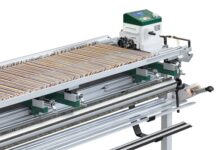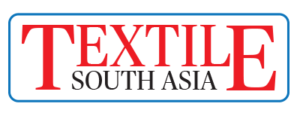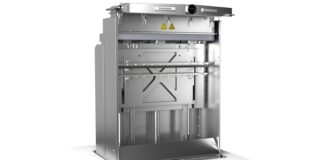
China is obviously one of world’s biggest textile markets. The industry there has experienced substantial growth and evolution, becoming a hub for textile production, innovation, and consumption. Swiss machinery manufacturers adapted in the past to the specific market situation and are now ready and able to support the future goals of China’s textile manufacturers.
In China, the textile industry is forward-looking and resilient – with a healthy appetite for new technologies and a determination to keep its leading position. Sustainability is increasingly coming into focus, so there is a growing demand for recycling technologies, as well as automated solutions and digitalization. Cornelia Buchwalder, Secretary General of the Swiss Textile Machinery Association, is clear: “China is the main market for a large number of our association members.”
Market proximity
Swiss companies realized many years ago that geographical proximity is the key to success. For example, Stäubli has started to set up offices in Chinese cities since 1998 and counts 12 locations today, to serve the whole country. In 2002, Itema established a centralized local branch which today has 160 employees in various functions. Loepfe has expanded its presence by creating an independent local business unit to overcome the 9,000 km distance by air, while Uster Technologies has had a Chinese subsidiary since 1982, with offices and service stations in different provinces. Luwa set up its offices and workshop in Shanghai in 1997. Rieter established a presence in mainland China in 2005, driven by a strong commitment to expanding the country’s know-how and expertise – and ten years later opened an advanced research center. “We are firmly committed to delivering cutting-edge technology and textile expertise to help the Chinese spinning industry stay at the forefront of innovation,” says Thomas Oetterli, CEO Rieter Group.
All Swiss companies with serious business goals in China have made similar commitments to connect with customers and maintain strong relationships. “Geographical proximity allows the companies to adopt a strong customer-centric approach and provide more effective local installation support, training, and field services to customers,” says Frank Naef, Head of Marketing, Loepfe Brothers.
Understanding customers
Swiss companies also understand that Chinese customers require dedicated attention, and that speed is more essential than ever in delivering both machines and services.
China’s move towards self-sufficiency is a continuing trend. Stäubli has developed local products for the Chinese market and built long-standing partnerships with many local companies. “The technical development of the partners goes hand in hand with our local competence, which we have built up in Hangzhou over the years,” says Fritz Legler, Textile Marketing Officer at Stäubli. Developments in new technology and automation are taking Chinese mills further into the digital age, with machinery incorporating intelligence and high engineering performance.
Manufacturers in China are seeking cost-effective solutions to remain competitive, while consumers are looking for value in their purchases. Companies need to develop solutions that provide tangible economic benefits to their clients. Furthermore, energy savings have become paramount in China, due to the government’s commitment to environmental sustainability and reduced carbon emissions. “Businesses are adopting more energy-efficient processes and technologies to meet stringent energy conservation and emission reduction targets,” says Peter Schnickmann, Managing Director at Luwa Air Engineering (Shanghai). He notes an investment trend for solutions helping Chinese companies cut operational costs and minimize their carbon footprint.
To enhance the reputation of both companies and products – and boost the image of the entire industry – the environmental impact needs to decrease. Priorities are saving water and waste, as well as reducing, replacing or completely eliminating the use of harmful substances. China has a strong demand for environmental-friendly solutions and sustainable technologies. “China is an important business partner for Benninger demanding salt-free dyeing solutions, water consumption figures and modern dispensing systems,” says Rolf Erik Schoeler, Head of Sales & Marketing at Benninger Group.
Customer-oriented in weaving
The huge number of Chinese fabric producers calls for an immense volume of weaving machinery to be supplied by international and local providers. Thanks to their customer-oriented approach, Swiss machinery manufacturers hold an impressive share of this business.
Chinese weavers require advanced technology, with increasingly higher standards of efficiency. Swiss Textile Machinery Association members meet these needs in many ways. In weaving preparation, latest solutions match the speed, quality and reliability now wanted. Weaving machines too offer the eco-efficiency, performance, and ease of use needed, with innovations that extend the scope of sustainable weaving, and open-platform systems configurable to weavers’ specific operations.
It’s important to note that Swiss weaving machinery is appreciated both by major manufacturers and by the smaller companies who need both reliable equipments, as well as expert training and ongoing support.
A huge increase in demand for technical textiles in recent years has been driven by applications such as carbon fiber, aramid and glass fiber. “We will take the occasion of the upcoming ITMA Asia in Shanghai to host an event sharing know-how and experience on technical fabrics,” says Matteo Mutti, Managing Director at Itema Switzerland.
Profitable in spinning
China’s competitive advantages come from its large-scale and integrated manufacturing capabilities, along with the use of advanced automation and digitization technologies. Spinners aim to capitalize on extended market opportunities, with more economical production. The latest air-jet spinning machines serve these goals, allowing exceptionally low production costs per kilogram of yarn, coupled with high flexibility and reliability.
Sustainable yarns are in great demand. Innovative systems from Swiss manufacturers enable spinners to produce fine, high-quality ring and compact yarns from challenging raw material. This holds true even with a relatively high proportion of mechanically recycled cotton fibres.
The automation trend in spinning mills focuses on connecting production processes. Data is used to ensure the highest quality standards, most efficient raw material usage, reduction of waste, and energy savings. To make spinning mills more competitive, latest solutions combine cutting-edge hardware, data-enabled software and renowned textile expertise.
For many decades, Uster has been working to improve and extend growth and quality management practices in China. “We are happy to have contributed positively to the successes and the reputation of Chinese textile products,” says Sivakumar Narayanan, Head of Marketing and Business Development at Uster Technologies.
Work together, meet together
On top of growing consumer demand and technological capabilities, the latest ambitious five-year plan will drive further development of the Chinese textile industry in world markets, and Swiss companies will work with all stakeholders to enable its success.
Swiss companies are especially close to players in the Chinese market, as will be demonstrated at the upcoming ITMA Asia + CITME in Shanghai. At the event, 15 association members look forward to seeing their many customers again – and meeting new ones. They are also keen to leave a deep impression by presenting their latest innovations. Information about exhibitors from the Swiss Textile Machinery Association and their booth locations is available at https://www.swisstextilemachinery.ch/stories/itmaasia-booth-location.







